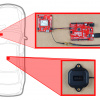Hello everyone! If you missed it last week, we released some new Qwiic boards last week that feature the BMA400 Triple Axis Accelerometer from Bosch and the LPS28DFW Absolute Digital Barometer from STMicroelectronics. These two chips were put on four different boards in both our Qwiic Standard and Qwiic Micro form-factors so you can decide to pick up which ever version you have the space for. Today, though, we are going to be taking a closer look at some projects we made with the Micro-sized versions of both boards!
The SparkFun Qwiic BMA400 Triple Axis Accelerometer Breakouts offer 3-axis acceleration sensors perfect for ultra-low-power applications on an easy-to-use Qwiic breakout board. Dubbed the first "real" ultra-low power acceleration sensor, the BMA400 is perfect when used in both wearable and smart home applications. Where this sensor shines, however, is its ability to distinguish between critical situations and false signals by avoiding false alarms. The Qwiic system allows for integration into your I2C system with no soldering required. The Standard-size Qwiic breakout also includes 0.1"-spaced PTH pins connected to the sensor's communication interface and interrupt pins for applications that require a traditional soldered connection. Meanwhile, even though the Micro-size version does not allow for a traditional 0.1"-spaced PTH header for communication, the board does route an interrupt and ground pin to a through-hole connection.
SparkFun Triple Axis Accelerometer Breakout - BMA400 (Qwiic) Hookup Guide
December 8, 2022
Add low power triple axis motion monitoring to your Qwiic project using the SparkFun Triple Axis Accelerometer Breakout - BMA400 (Qwiic).
The SparkFun Qwiic LPS28DFW Absolute Digital Barometers offer a unique barometer breakout featuring the LPS28DFW from STMicroelectronics©. The LPS28DFW is an absolute barometer with a water-resistant package making it perfect for pressure measurement applications where the sensor is exposed to or even submerged in water. The Qwiic system allows for integration into your I2C system with no soldering required. The Standard-size Qwiic breakout also includes 0.1"-spaced PTH pins connected to the sensor's communication interface and interrupt pins for applications that require a traditional soldered connection. Meanwhile, even though the Micro-size version does not allow for a traditional 0.1"-spaced PTH header for communication, the board does route an interrupt and ground pin to a through-hole connection.
SparkFun Absolute Digital Barometer - LPS28DFW (Qwiic) Hookup Guide
December 8, 2022
Get started adding water-resistant pressure sensing using the SparkFun Absolute Digital Barometer - LPS28DFW (Qwiic) following this guide.
That's pretty much it for today! We hope you enjoyed the videos and projects. Make sure to check out the tutorials that we've listed, as well, because there are a lot of tips and tricks that will help you get set up and running! We'll see you next time and thanks for stopping by!






